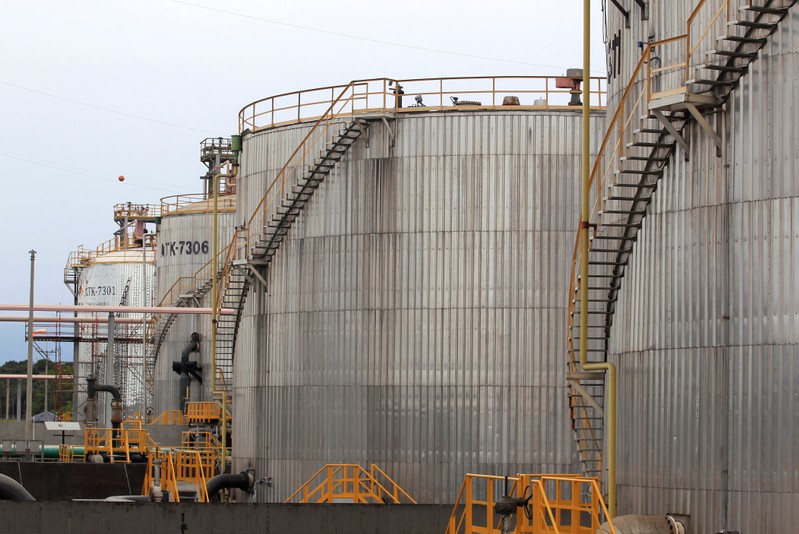
FILE PHOTO: Storage tanks are seen at Ecopetrol’s Castilla oil rig platform, in Castilla La Nueva, Colombia June 26, 2018. REUTERS/Luisa Gonzalez/File Photo
May 22, 2019
By Shadia Nasralla
LONDON (Reuters) – Oil prices fell on Wednesday after industry data showed an increase in U.S. crude inventories and on demand concerns linked to a protracted trade war between China and the United States.
However, analysts said oil markets remained tight amid supply cuts led by producer group OPEC and as political tension escalates in the Middle East.
Brent crude futures were down 70 cents at $71.48 a barrel by 0906 GMT and are set for their biggest daily fall in eleven days.
U.S. West Texas Intermediate (WTI) crude futures for July delivery were down 68 cents at $62.45.
“Buying pressures are sandwiched between mounting geopolitical disruption risks in the Middle East and jitters over the fallout from the intensifying U.S.-China trade dispute,” PVM’s Stephen Brennock said in a note.
“As a result, the oil market is at a crossroad with both these risks carrying the potential to send prices $10 a barrel in either direction… Even a modest bout of profit taking could quickly cascade into a selling frenzy.”
In a trade war between China and the United States, no further talks between top officials have been scheduled since the last round ended in a stalemate on May 10.
The conflict is weighing on economic growth forecasts and with that, oil demand predictions. The Organisation for Economic Co-Operation and Development (OECD) on Tuesday revised down its global growth forecast for the year.
Adding to bearish factors, industry body American Petroleum Institute (API) said on Tuesday that U.S. crude stockpiles rose by 2.4 million barrels last week.
Official data from the U.S Energy Information Administration’s oil stockpiles report is due at 1430 GMT. Analysts polled by Reuters estimated, on average, that crude inventories fell 600,000 barrels in the week to May 17. [EIA/S]
Beyond market fundamentals, oil traders are looking to the tensions between the United States and Iran. On Tuesday, acting U.S. Defense Secretary Patrick Shanahan said threats from Iran remained high.
Outside the United States, Saudi Arabia on Wednesday said it was committed to a balanced and sustainable oil market.
Saudi Arabia has been at the forefront of supply cuts led by the Organization of the Petroleum Exporting Countries (OPEC) that began in January.
U.S. bank Morgan Stanley said it expected Brent prices to trade in a $75-$80 per barrel range in the second-half of this year, pushed up by tight supply and demand fundamentals.
The physical oil market is also showing signs of tightness.
Qatar Petroleum has sold al-Shaheen July delivery crude at the highest average premium since 2013 on robust demand for medium-heavy grades in Asia, trade sources said.
(Additional reporting by Henning Gloystein in SINGAPORE and Aaron Sheldrick in TOKYO; Editing by Alexander Smith)

